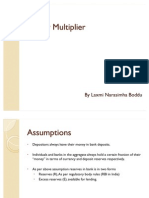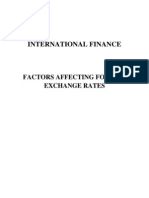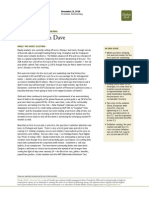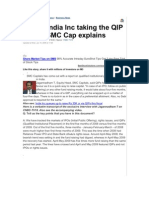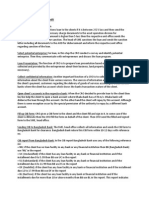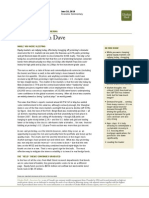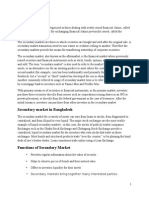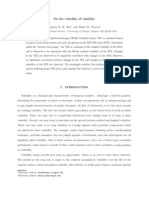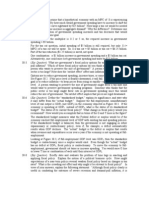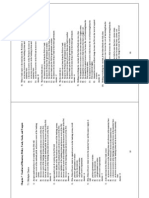Open Market Operations
Open Market Operations
Uploaded by
WickedadonisCopyright:
Available Formats
Open Market Operations
Open Market Operations
Uploaded by
WickedadonisOriginal Description:
Copyright
Available Formats
Share this document
Did you find this document useful?
Is this content inappropriate?
Copyright:
Available Formats
Open Market Operations
Open Market Operations
Uploaded by
WickedadonisCopyright:
Available Formats
Open Market Operations Printer version
Open market operations, or OMOs, are the Federal Reserve's most flexible and frequently used means of implementing U.S. monetary policy. The Federal Reserve has at its disposal several different types of OMOs, though the most commonly used are triparty repos and securities purchases. Open market operations enable the Federal Reserve to affect the supply of reserve balances in the banking system and thereby influence short-term interest rates and reach other monetary policy targets. In addition to open market operations, the Federal Reserve can impact the level of reserve balances by either reinvesting the proceeds of maturing securities in the System Open Market Account into new securities (reserve-neutral) or redeeming maturing securities (reserve-draining).
Open market operations are one of three basic tools used by the Federal Reserve to reach its monetary policy objectives. The other tools are changing the terms and conditions for borrowing at the discount window and adjusting reserve requirement ratios. The execution of OMOs in the "open market"also known as the secondary market for securities purchasesis the Federal Reserve's most flexible means of carrying out its objectives. By adjusting the level of reserve balances in the banking system through open market operations, the Fed can offset or support permanent, seasonal or cyclical shifts in the supply of reserve balances and thereby affect shortterm interest rates and by extension other interest rates. The FOMC and Monetary Policy The Federal Open Market Committee (FOMC) is the Federal Reserve Systems top monetary policy-making body. The FOMC delegates responsibility for implementing U.S. monetary policy to the Manager of the System Open Market Account (SOMA) at the Federal Reserve Bank of New York through the Authorization. This Authorization is contained in the minutes of the first FOMC meeting of each year. The SOMA Manager is responsible for the staff of the Trading Desk at the Federal Reserve Bank of New York (the Desk). The Desk thus executes open market operations on behalf of the entire Federal Reserve System. After each policy meeting, which occur every six to eight weeks, the FOMC issues a Directive to the SOMA Manager outlining the approach to monetary policy that the FOMC considers appropriate for the time period between its meetings. The Directive contains the rate at which the FOMC would like fed funds to trade over the intermeeting period. The FOMCs announcements of changes in monetary policy thus specify the changes in the Fed's target rate. Open Market Transactions The Federal Reserve conducts open market operations with primary dealersgovernment
securities dealers who have an established trading relationship with the Federal Reserve. So while the target policy rate is the uncollateralized lending rate between banks (fed funds), the Fed operates in the collateralized lending market with primary dealers (repo). This structure works because the primary dealers have accounts at clearing banks, which are depository institutions. So when the Fed sends and receives funds from the dealer's account at its clearing bank, this action adds or drains reserves to the banking system. Through this adjustment to the supply of reserve balances, open market operations influence the federal funds ratethe interest rate that depository institutions pay when they borrow unsecured loans of reserve balances overnight from each other. Banks borrow reserves in the federal funds market in order to meet reserve requirements set by the Federal Reserve, and to ensure adequate balances in their accounts at the Fed to cover checks and electronic payments that the Fed processes on their behalf. Changes in the federal funds rate often have a strong impact on other short-term rates. To most effectively influence the level of reserve balances, the Federal Reserve has created what is called a structural deficiency. That is, it has created permanent additions to the supply of reserve balances that are somewhat less than the total need. Then on a seasonal and daily basis, the Desk is in a position to add balances temporarily to get to the desired level. Specifically, the Desk has created the SOMA portfolio through the purchase of U.S. Treasury securities in the open market. Since the SOMA portfolio is a buy-and-hold portfolio, where securities purchased in it are typically held to maturity, a security purchase by the Fed results in a permanent increase in the level of reserve balances. In addition to the SOMA portfolio, the Feds total portfolio includes a long-term repo book and a short-term repo book. Repos, also called repurchase agreements or RPs, are a form of collateralized loan where the Fed lends money to primary dealers, and the primary dealers give the Fed high-quality securities as general collateral against the loan. While the SOMA portfolio is managed to offset factors that permanently drain balances from the banking systemlike Federal Reserve Notesthe long-term repo book is used to offset seasonal movements in factors. Long-term repos currently have a maturity of 14-days and are conducted early every Thursday morning. The short-term repo book, which consists of repos with shorter-than-14-day maturities, is dominated by overnight repos. These operations are typically conducted every day to fine-tune the level of banking reserves needed on that day. While typically these operations will add balances, occasionally the system will need to have balances extinguished, in which case the Desk will conduct a reverse repo. Reverse repo transactions are the opposite of RPs. Instead of lending money to the dealers, the desk borrows money from the dealers versus collateral from the System Open Market Account. Repo and reverse repos can be conducted for terms up to 65 business days. They are typically settled on a same-day basis, though they can be settled on a forward date as well. For
information on eligible collateral for repos, see the Federal Reserve Act, and the Domestic Authorization, which is in the minutes for the first FOMC meeting each year. Gathering Information, Preparing to Act Staff on the Desk start each workday by gathering information about the market's activities from a number of sources. The Fed's traders discuss with the primary dealers how the day might unfold in the securities market and how the dealers' task of financing their securities positions is progressing. Desk staff also talk with the large banks about their reserve needs and the banks' plans for meeting them and with fed funds brokers about activities in that market. Reserve forecasters at the New York Fed and at the Board of Governors in Washington, D.C., compile data on bank reserves for the previous day and make projections of factors that could affect reserves for future days. The staff also receives information from the Treasury about its balance at the Federal Reserve and assists the Treasury in managing this balance and Treasury accounts at commercial banks. Following the discussion with the Treasury, forecasts of reserves are completed. Then, after reviewing all of the information gathered from the various sources, Desk staff develop a plan of action for the day. That plan is reviewed with interested parties around the system during a conference call held each morning. Conditions in financial markets, including domestic securities and money markets and foreign exchange markets also are reviewed at this time. Conducting Open Market Operations When the conference call is complete, the Desk conducts any agreed-upon open market operations. The Desk initiates this process by announcing the OMO through an electronic auction system called FedTrade, inviting dealers to submit bids or offers as appropriate. For a repo operation, the announcement states the auction close time, repo type (repo or reverse) and term of the operation, but does not specify its size. The size of the operation is announced later, after the operation is completed. The dealers' propositions are evaluated on a competitive best-price basis. Primary dealers typically are given about 10 minutes to submit their propositions and are notified of the results about a minute after the close of the auction. Auction results are also simultaneously sent to the Banks external website and to the wire services. Auctions for outright security purchases into the SOMA portfolio are typically arranged later in the morning and follow a similar procedure to repo. The announcement contains the maturity range for securities the Fed is looking to purchase, as well as a list of any securities to be excluded in this maturity range. These operations tend to be open about 30 minutes. Dealers bid on securities, and the Fed compares the relative richness of propositions across securities, accepting the best relative rates from the propositions submitted. When securities in the SOMA portfolio mature, which happens every week with bills and every month for different maturity notes and bonds, the Desk determines whether to reinvest the maturing proceeds into new Treasury debt issued at primary auction, or to redeem the maturing
proceeds. Typically the proceeds are reinvested, which would maintain the size of the SOMA portfolio and therefore the size of the permanent reserve-adding nature of the portfolio. Occasionally, due to portfolio guidelines or reserve needs, proceeds are redeemed, which reduces the size of the SOMA portfolio and effectively drains reserve balances from the banking system. August 2007
You might also like
- FX Memo GuideDocument12 pagesFX Memo Guidemuhammedabdulhadi06No ratings yet
- Mabvax V Barry Honig First - Amended - Complaint - Aug 28 2020Document65 pagesMabvax V Barry Honig First - Amended - Complaint - Aug 28 2020Teri BuhlNo ratings yet
- Financial Statement Analysis of BG Group Plc.Document34 pagesFinancial Statement Analysis of BG Group Plc.Saurabh MalikNo ratings yet
- How Dealers Conduct Foreign Exchange Operations: All About..Document10 pagesHow Dealers Conduct Foreign Exchange Operations: All About..WickedadonisNo ratings yet
- Dave Rosenberg Gluskin Sheff 01/07/2010Document12 pagesDave Rosenberg Gluskin Sheff 01/07/2010ETFDesk.comNo ratings yet
- The New Bull Market FallacyDocument22 pagesThe New Bull Market FallacyNaufal Sanaullah100% (2)
- Breakfast With Dave 20100928Document8 pagesBreakfast With Dave 20100928marketpanicNo ratings yet
- Chapter 2 Tutorial AnswersDocument5 pagesChapter 2 Tutorial AnswersHeri LimNo ratings yet
- FFTT "Tree Rings": The 10 Most Interesting Things: We 'Ve Read RecentlyDocument25 pagesFFTT "Tree Rings": The 10 Most Interesting Things: We 'Ve Read RecentlyMadeleine ChewNo ratings yet
- Money MultiplierDocument12 pagesMoney Multiplierlaxmi_boddu100% (1)
- International Finance: Factors Affecting Foreign Exchange RatesDocument8 pagesInternational Finance: Factors Affecting Foreign Exchange Ratesvan_1234100% (1)
- Rip Off by The Federal Reserve Feb 17 2011Document12 pagesRip Off by The Federal Reserve Feb 17 2011leomer7697No ratings yet
- Tools of Monetary PolicyDocument19 pagesTools of Monetary PolicyHoney HonNo ratings yet
- Closed End VS Open End FundsDocument2 pagesClosed End VS Open End Fundspingu_513501No ratings yet
- Topic I Introduction To CreditDocument4 pagesTopic I Introduction To CreditLemon OwNo ratings yet
- Breakfast With Dave 082010Document15 pagesBreakfast With Dave 082010richardck50No ratings yet
- China Interbank Bond Market and FX MarketDocument60 pagesChina Interbank Bond Market and FX MarketbondbondNo ratings yet
- GK FMI QA 1Document9 pagesGK FMI QA 1Phan NhiNo ratings yet
- Breakfast With Dave 112210Document15 pagesBreakfast With Dave 112210richardck50No ratings yet
- Forex MarketDocument49 pagesForex MarketSanjay ReddyNo ratings yet
- After The Storm FinalDocument106 pagesAfter The Storm FinalNye Lavalle100% (1)
- The Euro-Dollar Market Friedman Principles - Jul1971Document9 pagesThe Euro-Dollar Market Friedman Principles - Jul1971Deep. L. DuquesneNo ratings yet
- Exchange Rate Determination & Factors Forecasting: Unit IiDocument27 pagesExchange Rate Determination & Factors Forecasting: Unit Iikeenu23No ratings yet
- FX Risk Management Transaction Exposure: Slide 1Document55 pagesFX Risk Management Transaction Exposure: Slide 1prakashputtuNo ratings yet
- Money BankingDocument27 pagesMoney BankingParesh ShrivastavaNo ratings yet
- Unit 5 Money and BankingDocument4 pagesUnit 5 Money and Bankingrajanityagi23No ratings yet
- IX. How To Read Financial Bond Pages: Notes HDocument7 pagesIX. How To Read Financial Bond Pages: Notes HZvioule Ma FuentesNo ratings yet
- Price FixingDocument1 pagePrice FixingMerryshyra MisagalNo ratings yet
- V V V V:) V) V5V$V VV V VV9V8) VVDocument2 pagesV V V V:) V) V5V$V VV V VV9V8) VVBhavneesh ShuklaNo ratings yet
- ER Ch05 Solution ManualDocument14 pagesER Ch05 Solution Manualsupering143No ratings yet
- International TradeDocument7 pagesInternational TradeReddy Haveri100% (1)
- CibDocument6 pagesCibAriful Haque SajibNo ratings yet
- Unit - 4.4 Hawtrey's Theory.Document3 pagesUnit - 4.4 Hawtrey's Theory.Mahima guptaNo ratings yet
- Bank of EnglandDocument2 pagesBank of EnglandElena Mădălina CioineagNo ratings yet
- 06-14-10 Breakfast With DaveDocument7 pages06-14-10 Breakfast With DavefcamargoeNo ratings yet
- Controlling Inflation ProjectDocument29 pagesControlling Inflation Projecthimanshushah871006No ratings yet
- 06-10-10 Breakfast With DaveDocument8 pages06-10-10 Breakfast With DavefcamargoeNo ratings yet
- Currency Crisis: How Much Longer Until It Hits The US?Document3 pagesCurrency Crisis: How Much Longer Until It Hits The US?Pankaj PatilNo ratings yet
- International Financial PPT PpresentationDocument41 pagesInternational Financial PPT PpresentationSambeet ParidaNo ratings yet
- Unit 1: Money and BankingDocument48 pagesUnit 1: Money and BankingAbhikaam Sharma100% (1)
- Forward Foreign Exchange ContractsDocument26 pagesForward Foreign Exchange ContractsmuffadNo ratings yet
- The Foreign Exchange MarketDocument16 pagesThe Foreign Exchange Marketmanojpatel5167% (3)
- The Secondary MarketDocument13 pagesThe Secondary MarketDhushor SalimNo ratings yet
- On The Volatility of Volatility: Electronic Address: Hsu@duende - Uoregon.edu Electronic Address: Bmurray1@uoregon - EduDocument15 pagesOn The Volatility of Volatility: Electronic Address: Hsu@duende - Uoregon.edu Electronic Address: Bmurray1@uoregon - EduKelvin LeungNo ratings yet
- Chapter 3Document8 pagesChapter 3Siful Islam Anik100% (1)
- TBAC TSY Buyback PresentationDocument40 pagesTBAC TSY Buyback PresentationZerohedgeNo ratings yet
- Final Project On Volatility - New 2Document99 pagesFinal Project On Volatility - New 2vipul099No ratings yet
- Rfi On Transparency 2022 (6.27.22)Document5 pagesRfi On Transparency 2022 (6.27.22)Carlos100% (1)
- Treasury MGMT Introduction 1Document31 pagesTreasury MGMT Introduction 1Saurab JainNo ratings yet
- Marco Economics Sem - 2 FC - 1Document28 pagesMarco Economics Sem - 2 FC - 1Sharath KanzalNo ratings yet
- Understanding Multiple Deposit Creation and The Money SupplyDocument36 pagesUnderstanding Multiple Deposit Creation and The Money SupplyJames EstradaNo ratings yet
- Effect of US Government Policies On The Financial Markets and The World EconomyDocument179 pagesEffect of US Government Policies On The Financial Markets and The World EconomyAfrican ViewsNo ratings yet
- Money Banking Practice Questions and AnswersDocument3 pagesMoney Banking Practice Questions and AnswersNihad RüstəmsoyNo ratings yet
- A Look at What Constitutes Unfair Practice and How You Can Ensure You Always Play Fair in The Eyes of The LawDocument1 pageA Look at What Constitutes Unfair Practice and How You Can Ensure You Always Play Fair in The Eyes of The LawguptevaibhavNo ratings yet
- Basel 3 NormsDocument14 pagesBasel 3 Normsnidazaidi1989No ratings yet
- Banking Institutions History Classifications and FunctionsDocument13 pagesBanking Institutions History Classifications and FunctionsJessielyn GialogoNo ratings yet
- Unit 7 Central Banking - ESP Int'l Banking and FinanceDocument27 pagesUnit 7 Central Banking - ESP Int'l Banking and FinanceUyên PhươngNo ratings yet
- Lecture Notes 3 (Central Bank)Document5 pagesLecture Notes 3 (Central Bank)ssahlo996No ratings yet
- Federal Reserve Bank of New York Staff Reports: Reserve Levels and Intraday Federal Funds Rate BehaviorDocument27 pagesFederal Reserve Bank of New York Staff Reports: Reserve Levels and Intraday Federal Funds Rate BehaviorscribddownloadedNo ratings yet
- Fed Rate Cut N ImplicationsDocument8 pagesFed Rate Cut N Implicationssplusk100% (1)
- Interbank Lending MarketDocument7 pagesInterbank Lending Markettimothy454No ratings yet
- WBS StructureDocument17 pagesWBS StructureWickedadonis0% (1)
- Andaz Apna Apna Teaches 15 Important Life LessonsDocument16 pagesAndaz Apna Apna Teaches 15 Important Life LessonsWickedadonisNo ratings yet
- Ops KPODocument5 pagesOps KPOWickedadonisNo ratings yet
- Economic StrategyDocument84 pagesEconomic StrategyWickedadonisNo ratings yet
- GlobalizationDocument16 pagesGlobalizationWickedadonisNo ratings yet
- Financial Services: A Bank For BanksDocument2 pagesFinancial Services: A Bank For BanksWickedadonisNo ratings yet
- There's A Lot To Learn About MoneyDocument8 pagesThere's A Lot To Learn About MoneyWickedadonisNo ratings yet
- 18e Key Question Answers CH 30Document3 pages18e Key Question Answers CH 30pikachu_latias_latiosNo ratings yet
- Case Econ08 PPT 22Document40 pagesCase Econ08 PPT 22Danan Imananda100% (1)
- Chap 24 Econ 40Document4 pagesChap 24 Econ 40Racel DelacruzNo ratings yet
- API FR - INR.RINR DS2 en Excel v2 5358547Document74 pagesAPI FR - INR.RINR DS2 en Excel v2 5358547Hasbi YallahNo ratings yet
- Chapter 7 Conduct of Monetary Policy: Tools, Goals, and TargetsDocument10 pagesChapter 7 Conduct of Monetary Policy: Tools, Goals, and TargetskiracimaoNo ratings yet
- Study Guide 8 S2014Document8 pagesStudy Guide 8 S2014Nowell Tannie0% (1)
- API FR - Inr.lend Ds2 en Excel v2 5729145Document68 pagesAPI FR - Inr.lend Ds2 en Excel v2 5729145Tijani Bolaji usmanNo ratings yet
- FBI TBCh07Document10 pagesFBI TBCh07vincewk179No ratings yet
- Public Finance McqsDocument17 pagesPublic Finance Mcqssanubro007No ratings yet
- Monetary Policy of BangladeshDocument11 pagesMonetary Policy of BangladeshGobinda sahaNo ratings yet
- Chapter 04 Functions of The FedDocument26 pagesChapter 04 Functions of The FedSarah MoonNo ratings yet
- ECO121 Individual Assignment 02 Test 02 Summer2024Document5 pagesECO121 Individual Assignment 02 Test 02 Summer2024Do Thuy NgaNo ratings yet
- T NG H P GraphsDocument8 pagesT NG H P GraphsAnnie DuolingoNo ratings yet
- Economics 1bDocument16 pagesEconomics 1bCindy ManfoNo ratings yet
- Expansionary & Restrictive Monetary PolicyDocument29 pagesExpansionary & Restrictive Monetary PolicyIsabella Yao100% (1)
- The Economics of Money, Banking, and Financial Markets: Twelfth Edition, Global EditionDocument29 pagesThe Economics of Money, Banking, and Financial Markets: Twelfth Edition, Global Editionsawmon myintNo ratings yet
- ECB European Central BankDocument12 pagesECB European Central BankHiral SoniNo ratings yet
- Ongkos Kirim Tiki Luar NegeriDocument5 pagesOngkos Kirim Tiki Luar NegeriWahanas KuatNo ratings yet
- Economy Results Due To Faulty Legal System and Unjust State of Georgia Convictions On All 5 Counts of Banks' Cases of Innocent Srinivas VaddeDocument1,553 pagesEconomy Results Due To Faulty Legal System and Unjust State of Georgia Convictions On All 5 Counts of Banks' Cases of Innocent Srinivas VaddesvvpassNo ratings yet
- CH15 Mish11ge ArabicDocument47 pagesCH15 Mish11ge ArabicFadi OsamaNo ratings yet
- Kautilya Batch: Determination of Income & EmploymentDocument3 pagesKautilya Batch: Determination of Income & EmploymentHarshit TripathiNo ratings yet
- Introduction To The Money SupplyDocument3 pagesIntroduction To The Money SupplyamitwaghelaNo ratings yet
- Economics of Monetary Union 12th Edition Paul de Grauwe 2024 Scribd DownloadDocument62 pagesEconomics of Monetary Union 12th Edition Paul de Grauwe 2024 Scribd Downloadkebenesalish100% (2)
- Fractional RBDocument7 pagesFractional RBRichard VemeNo ratings yet
- Efforts To Reduce The Budget DeficitDocument6 pagesEfforts To Reduce The Budget DeficitNikkiNapalmNo ratings yet
- 2moneybanking 211118133229Document33 pages2moneybanking 211118133229geetaNo ratings yet
- Practice Questions With Answers (Monetary and Fiscal Policy)Document4 pagesPractice Questions With Answers (Monetary and Fiscal Policy)Giovanni LiporaceNo ratings yet
- Bill Gross Investment Outlook For 10 AM EST JULY 21 2023Document3 pagesBill Gross Investment Outlook For 10 AM EST JULY 21 2023blind_cryNo ratings yet
- Aa13 Eba (Tam)Document7 pagesAa13 Eba (Tam)Maiylvaganam ThishanthanNo ratings yet
- Money Supply Components and Their TrendsDocument4 pagesMoney Supply Components and Their TrendsAhamed AzarNo ratings yet









